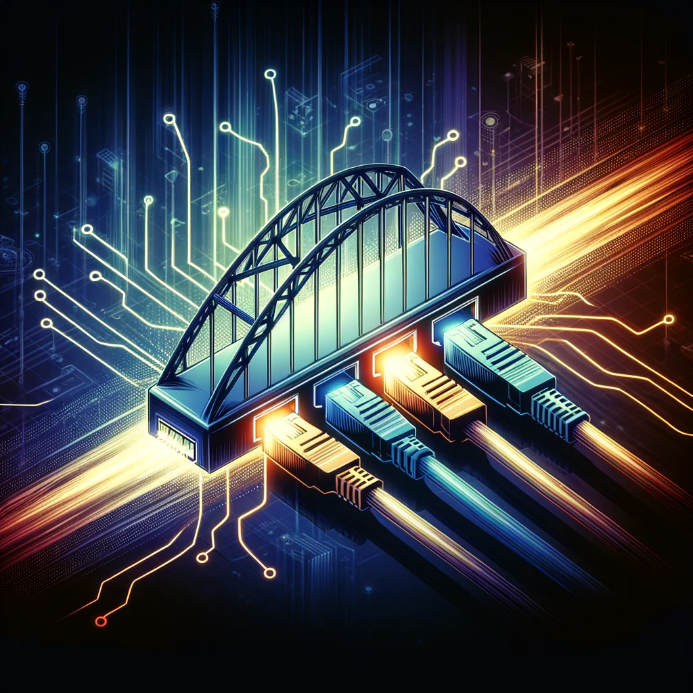Use and advantages of bridge devices in OT networks
Basic information about the product category of bridge devices
In OT (Operational Technology), networks play a central role in the efficient communication and control of industrial systems. Bridge devices, also known as network bridges, are components in the architecture of OT networks. They enable the connection and exchange of data between different network segments or subnetworks without the need to fundamentally change the network structure. These devices play a key role in reducing the complexity of network management while increasing the efficiency and security of data transmission.
Advantages of bridge devices
- Improved network security (OT security): By isolating network segments, bridge devices can help limit the spread of network threats and therefore increase the security of the overall network.
- Flexibility and scalability: The ability to connect different network technologies and protocols, such as PROFINET, Ethernet IP, OPC UA, MQTT and many more, makes bridge devices a flexible solution for expanding and customizing OT networks.
- Cost reduction: Bridge devices eliminate the need for extensive network restructuring. This can save considerable investment in the network infrastructure.
- Increased efficiency: They optimize data traffic by only forwarding relevant data between subnetworks. This reduces unnecessary network traffic and increases the performance of the network.
Challenges for network managers in OT
Network planners and network managers such as maintenance engineers, OT network administrators or OT security managers face a variety of challenges due to the specific requirements of industrial networks. These challenges arise from the need to ensure the highest levels of reliability, security and efficiency, while at the same time integrating new technologies necessitated by continuous change and coping with increasing data volumes.
1. Guarantee of network security
- Protection against security threats: OT networks are increasingly the target of OT security incidents coming from within, rather than from the higher network layers, which aim to compromise industrial control systems and end devices. Ensuring security against such threats is one of the biggest challenges.
- Securing legacy systems (existing systems): Many industrial networks are based on older, often no longer supported assets such as devices or software, which are highly susceptible to security vulnerabilities.
2. Ensuring network reliability and availability
- High availability requirements: Industrial processes require almost 100% network availability in order to achieve high production reliability and avoid costly downtimes as well as unnecessary production interruptions.
- Dealing with environmental conditions: OT networks need to function in a variety of environments, including those with extreme temperatures, humidity or dust, which puts a strain on network hardware.
3. Integration of heterogeneous systems
- Communication between different Ethernet-based applications: The need to integrate a variety of devices and protocols is a significant challenge, especially when it comes to integrating legacy systems.
- Interoperability between IT and OT: The increasing convergence of IT and OT networks requires solutions that enable seamless communication between very different system worlds.
4. Scaling and flexibility of the network
- Adaptation to growing data volumes: With the increasing digitalization of the process control and production levels, the demands on the network infrastructure to efficiently process and store large amounts of data are also increasing.
- Scalability: Networks must be universal and be able to be flexibly expanded to support new applications and technologies without requiring a complete overhaul of the existing infrastructure.
5. Management and maintenance
- Complexity of network management: Managing and maintaining OT networks required specialized knowledge and resources, especially when it came to updating software and troubleshooting.
- Budget and resource constraints: There are often not enough financial resources or specialists available to keep the network infrastructure up to date or to improve it.
Overcoming these challenges requires careful planning, the selection of suitable technologies and solutions as well as continuous monitoring and adaptation of the network infrastructure. Bridge devices such as the D*Bridge can play a crucial role by facilitating integration and security within the OT network and contributing to its stability and efficiency.
The bridge device D*Bridge from Indu-Sol
The D*Bridge digitalization bridge represents an advanced solution in the world of OT network communication. Designed as a bridge device, it overcomes the traditional challenges of data-intensive OT networks through intelligent, seamless and secure communication between previously homogeneous fieldbuses. The D*Bridge is very convenient for the user and virtually configuration-free thanks to I-Device technology and effectively supports the communication of PROFINET and smart sensors (e.g. SIEDS) by ensuring a stable and secure network environment in accordance with IEC 62443-3.
Highlights of the D*Bridge
- Simple and secure newtworking: The D*Bridge simplifies the integration of Ethernet-based fieldbus systems and enables seamless horizontal communication without the usual configuration effort required for PN/PN couplers, for example.
- Prioritization of communication protocols: With a focus on PROFINET and smart sensor communication, the D*Bridge ensures targeted prioritization of data traffic to improve the efficiency and responsiveness of the network.
- Automation of data exchange: The ability to automatically detect and control data traffic minimizes human intervention and increases network reliability.
- Solution for data traffic problems: The D*Bridge effectively addresses and solves problems of unwanted data traffic, e.g. broadcast, double addressing, which contributes to the stability and availability of the network.
PProduct features
- Integrated network management via web interface: A dedicated web server enables efficient network management and simplifies the monitoring and administration of network traffic.
- Support of communication protocols: The D*Bridge supports a variety of relevant communication protocols, e.g. PROFINET, Ethernet IP, OPC UA, MQTT, making it a versatile solution for different applications.
- Reliability through redundant power supply: The D*Bridge guarantees uninterrupted operability even in critical network environments.
Variants of the D*Bridge
- D*Bridge H: Specially developed for horizontal networking of fieldbuses on the shopfloor.
- D*Bridge V: Provides a vertical connection to the SCADA system and the higher network levels (IT) to enable comprehensive network integration.
By using the D*Bridge in OT networks, companies can achieve optimized, secure and efficient data communication that meets both the current and future requirements of industrial automation.
The D*Bridge is part of the powerful CM&SM system (Condition Monitoring & Security Management System). Further information can be found here.
Further information and technical details about the D*Bridge:




